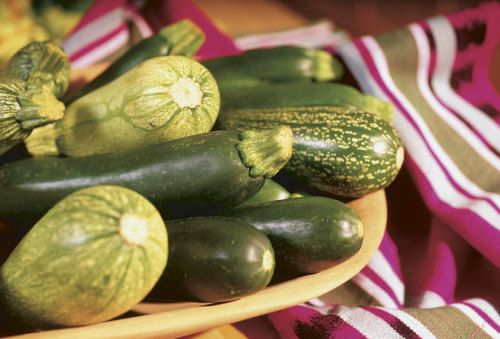
by Rick Bayless
April 1998
from issue #14
Color is the spark that ignites a passion in most visitors to Mexico, from the brilliance of Chiapaneco costumes and tropical blooms to marketplaces that thrill with a constant staccato of shade and hue. Heaps of dead-ripe red tomatoes or fragrant guavas or dried chiles catch most eyes first, though it’s the verdant tones of wild greens, herbs, and squash that have for years kept my interest.
As a student in Mexico a couple of decades ago, I was charmed by the pale-green zucchini I found. Whether they were tennis-ball-size spheres or elongated teardrops (they’re shorter than our dark-green zucchini), these calabacitas won me over with their firm texture and sweet flavor. When using stateside zucchini in Mexican recipes, I like to salt the sliced or diced raw squash, then let it stand in a colander for half an hour to draw out some of its bitterness and compact its texture.
Zucchini takes the lead in many dishes. Any soft-skinned, tender-fleshed squash in Mexico will be called the diminutive calabacita. Full-fledged calabaza is a term reserved for large, thick-skinned, hard-fleshed relatives of the pumpkin. North of the border, in non-ethnic markets, I’ve found the light-skinned Mexican favorites labeled generically as Mexican white zucchini. I’ve also cooked with ‘Ronde de Nice’, a tasty, round variety.
Beyond the much-appreciated fruit of the plant, the blossoms (flores de calabaza) are celebrated by cooks throughout the Republic. And in southern Mexico, the tender flowers find their way into many regional specialties.
To showcase the uniqueness of Mexican zucchini, I prepare them simply—sautéed with toasted garlic and a squeeze of lime (Quick-Fried Zucchini with Toasted Garlic and Lime), the way I learned from a taco-stand cook who spooned this concoction into steaming corn tortillas, sprinkled them with crumbled, tangy, fresh cheese, and called it a meal. This filling is also the right counterpoint for spicy grilled fish.
In the Mexican kitchen, zucchini is also counted on for a supporting role in caldos (brothy soups), cremas (cream soups), and in guisados (slow-simmered main dishes) for which the cuisine is justly famous. Though noodle dishes aren’t a mainstay in Mexico, fideos simmered in brothy tomato sauce provides everyday sustenance. Add, as my friend Lula Bertán does, a few handfuls of zucchini, the smoky sting of chipotle chiles, a little chorizo sausage, thick cream, and aged cheese, and fideos becomes the centerpiece of a celebration.
Another classic of Mexican cuisine combines roasted peppers (usually poblanos) with slivers of browned onion, fresh corn, and cream. Stir in some browned zucchini, and the tastes become even more beguiling (Zucchini with Roasted Peppers, Corn, and Cream). With the addition of chicken or Mexican fresh cheese (queso fresco), you have a hearty main dish that begs for warm tortillas and some Mexican rice.
Zucchini blossoms won’t play second fiddle. Zucchini are the rabbits, shall we say, of the vegetable world, producing copious offspring amid daily shows of mustard-yellow blossoms. The male blossoms (those with the singular, tubular stamens), while necessary for fertilization of the other half, don’t bear fruit and so can be harvested in great quantity. In Mexico they’re harvested in numbers large enough that any cook feels comfortable chopping them to stew with tomatoes, green chiles, and forthright epazote—an exuberant filling for humble quesadillas.
The squash blossom dish of dreams, though, is Golden Squash Blossom Crema. Echoing the poblano-corn-cream-zucchini chorus, this classic, classy, pale yellow wonder weaves in the hauntingly floral descant that hovers brilliantly over some of the most satisfying flavors known to the human race.
How to pick, prepare, and store zucchini blossoms
Squash and zucchini blossoms are the most fragile, most ethereal part of the plant. For both cook and consumer, to enjoy blossoms is to capture an exhilarating moment. After all, “the Earth laughs in flowers,” Emerson said.
Pick male blossoms daily after the dew is off; they wither before day’s end, and dampness makes them decay. Pick early to get open blossoms for stuffing or shredding into salads, later to get closed ones that store more easily. Store in the warmest part of the refrigerator in single layers with paper towels on top and bottom, loosely wrapped in a plastic bag. Leave female blossoms to produce fruit. Though fresh is best, blossoms will be fine for about three days, especially if used for cooked dishes.
‘Spooktacular’ and ‘Buttercup’, two varieties we grew last summer, produced copious amounts of male blossoms. ‘Buttercup’ is a ruffled, fragrant delight.
Sources for Mexican Zucchini
The Cook’s Garden
PO Box C5030
Warminster, PA 18974
‘Ronde de Nice’
www.cooksgarden.com
Johnny’s Selected Seeds
955 Benton Avenue
Winslow, Maine 04901
877-564-6697
‘Buttercup’
www.johnnysseeds.com
Renee’s Garden Seeds
6116 Highway 9
Felton, CA 95018
888-880-7228
‘Ronde de Nice’
www.reneesgarden.com
Seeds of Change
PO Box 15700
Santa Fe, NM 87506
888-762-7333
‘Buttercup’
www.seedsofchange.com


















Comments
Log in or create an account to post a comment.
Sign up Log in